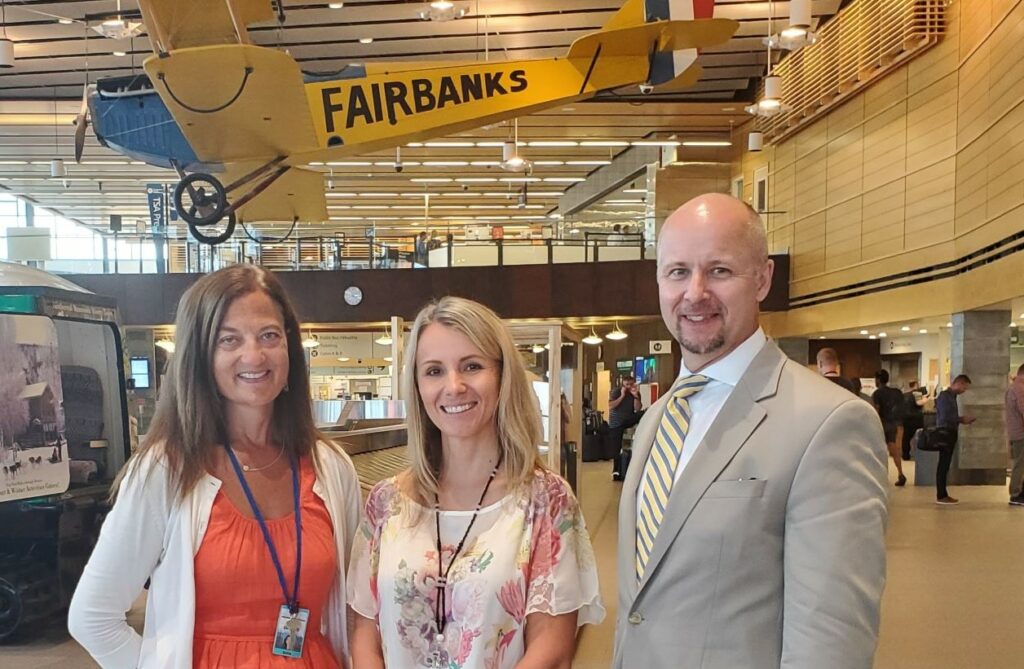By Bruce Lundegren, Assistant Chief Counsel
The SBA Office of Advocacy visited with officials at Ted Stevens Anchorage International and Fairbanks International airports during its recent visit to Alaska to hear about regulations that are affecting their operations. Representatives from the Alaska Air Carriers Association also participated.
One of the main issues discussed was the U.S. Transit Without Visa (TWOV) rules. Generally, a citizen of a foreign country who wishes to enter the United States must first obtain a visa. However, the Department of Homeland Security’s Visa Waiver Program allows citizens or nationals of some designated countries to travel to the United States for tourism or business for up to 90 days without a visa. Citizens or nationals of other countries—notably China—are not eligible for this program and must obtain a U.S. visa. This is having a negative impact on Alaska airports, particularly Anchorage.

As explained by Jim Szczesniak, the airport manager at Anchorage International, Anchorage would like to become a major transit hub and refueling point for flights between Asia and Latin America. However, because many of these travelers are not eligible for the Visa Waiver Program and do not have U.S. visas, airlines choose other airports instead of Anchorage. Mr. Szczesniak believes this is costing Anchorage a lot of money in lost sales and tourism. He would like to see the Transit Without Visa rules modified to allow international passengers to deplane at Anchorage within the secure area of the terminal and eat or shop while the plane is serviced and refueled. He stresses that they would not be allowed to exit the terminal and would be unable to clear U.S. customs. He also noted that because so few airlines fly to Anchorage, many would-be tourists are choosing destinations other than Alaska.
Angie Spear, the airport manager at Fairbanks International, took Advocacy on a tour of their recently renovated terminal and showed the secure areas they have built in the international terminal should the TWOV rules change. She felt that Anchorage feels this issue more than Fairbanks, since it is a much larger airport and the more likely international transit stop. She noted that Anchorage and Fairbanks attract different types of tourists. People flock to Anchorage for its summer daylight and outdoor activities, while Fairbanks attracts winter travelers in search of the Aurora Borealis – the Northern Lights.
In addition to these issues, representatives of the Alaska Air Carriers Association raised several concerns about restrictions on FAA funding. In particular, they want to use Airport Improvement Program (AIP) funds to build operational capacity for Anchorage. They also want the agency to let them use AIP funds to build modern weather reporting systems at small rural airports. These are vitally important to Alaska because the state is so large and has many remote areas without roads. As the representatives explained, weather is a critical safety issue in Alaska, and these small airports cannot afford modern weather reporting systems without federal funding.
Advocacy was in Alaska for Regional Regulatory Reform Roundtables July 9-11.
Can’t get to a roundtable near you? Fill out this form and tell us about your federal regulatory burdens. We will pass this information on to the appropriate agency and use it in the planning of upcoming Regional Regulatory Reform Roundtables.
For more information on Advocacy’s mission, our regulatory reform efforts or to find out where the next Regional Regulatory Reform Roundtables will be held, please visit: https://advocacy.sba.gov/regulation/regulatory-reform/.
Bruce Lundegren is an Assistant Chief Counsel for Advocacy whose portfolio includes safety, transportation, and security. Lundegren can be reached at bruce.lundegren@sba.gov.
